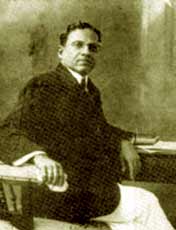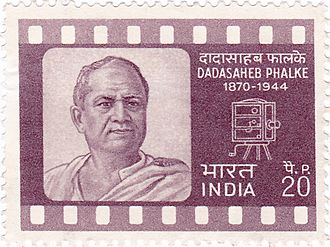Dadasaheb Phalke facts for kids
Quick facts for kids
Dadasaheb Phalke
|
|
|---|---|

Phalke seated on a chair with a small roll of film in his hands
|
|
| Born |
Dhundiraj Govind Phalke
30 April 1870 |
| Died | 16 February 1944 (aged 73) Nashik, Bombay Presidency, British India (present-day Maharashtra, India)
|
| Alma mater |
|
| Occupation |
|
| Years active | 1912–1944 |
| Spouse(s) |
|
Dhundiraj Govind Phalke (born 30 April 1870 – died 16 February 1944), known to everyone as Dadasaheb Phalke, was an Indian film director, producer, and writer. He is often called "the Father of Indian cinema" because he made India's first full-length movie.
His first film, Raja Harishchandra, came out in 1913. It was a very important moment for Indian movies! Over 19 years, until 1937, he made 95 full-length films and 27 short films. Some of his most famous works include Mohini Bhasmasur (1913), Satyavan Savitri (1914), Lanka Dahan (1917), Shri Krishna Janma (1918), and Kaliya Mardan (1919).
The Dadasaheb Phalke Award, a top honor for people who have done amazing work in Indian cinema, is named after him. The Government of India gives out this award every year.
Early Life and Learning
Dhundiraj Phalke was born on April 30, 1870, in Trimbak, which was part of British India back then. His family spoke Marathi. His father, Govind Sadashiv Phalke, was a Sanskrit scholar and a Hindu priest. His mother, Dwarkabai, was a homemaker. Phalke was one of seven children.
He started his education in Trimbakeshwar and later moved to Bombay (now Mumbai) with his family when his father became a professor.
In 1885, Phalke joined the Sir J. J. School of Art in Bombay to study drawing. A year later, he went to Baroda and continued his studies at Kala Bhavan, which is part of the Maharaja Sayajirao University of Baroda. He learned oil painting, watercolor painting, architecture, and modelling.
Around 1890, Phalke bought a camera and began experimenting with photography. He even won a gold medal in 1892 for designing an ideal theater model! He also learned how to make special printing blocks and work in a darkroom.
Career Beginnings
1893–1911: From Photography to Printing
In 1893, Phalke started his own photo studio and printing business. Even though he was very skilled, it was hard for him to make a steady living. So, in 1895, he moved to Godhra to become a professional photographer.
Sadly, in 1900, he lost his first wife and a child to a plague. He then moved back to Baroda and tried his photography business again. But people in the city had a strange belief that cameras would "suck out" a person's energy, which made it hard for his business to succeed. He then started painting stage curtains for drama companies, which taught him a lot about theater.
Phalke also learned magic tricks from a German magician. This skill later helped him create special effects in his films! In 1901, he even performed magic shows under the name "Professor Kelpha."
In 1902, Phalke remarried to Girija Karandikar, who was renamed Saraswati. In 1903, he worked as a photographer for the Archaeological Survey of India, but he wasn't happy with the job. So, in 1906, he opened a printing press called "Phalke Engraving and Printing Works." This business grew, and he even traveled to Germany in 1909 to buy new printing machines. However, he eventually left the printing business due due to disagreements with his partners.
1911–1917: Starting His Film Journey
First Steps and London Trip
After leaving his printing business, Phalke saw a film called Amazing Animals in 1911. The next day, he watched a film about Jesus, The Life of Christ. While watching, he imagined Hindu gods like Rama and Krishna on screen. This inspired him to start making "moving pictures" in India!
For a year, Phalke studied everything he could about filmmaking. He bought a small camera and started practicing. He watched movies for hours every night, which strained his eyes and caused him to lose his sight temporarily. Luckily, doctors helped him get his vision back.
Phalke wanted to go to London to learn more about filmmaking, but he needed money. He managed to get a loan by using his insurance policies as security. On February 1, 1912, he sailed to London.
In London, he met Mr. Cabourn, an editor of a film magazine, who introduced him to famous film director Cecil Hepworth. Hepworth allowed Phalke to see how a film studio worked. Phalke bought a special camera and film from London and returned to India on April 1, 1912. On the same day, he started his own company, "Phalke Films Company."
Making Raja Harishchandra
Back in India, Phalke set up a small studio at his home in Dadar, Bombay. He taught his family how to prepare film. To test his equipment and get investors, he made a short film called Ankurachi Wadh (Growth of a Pea Plant). It showed a pea seed growing into a plant, filmed one frame a day for a month! This short film helped him get loans from people who saw its potential.
Phalke then decided to make a film based on the story of King Harishchandra. He put out ads for actors, but since women didn't act in films back then, male actors played the female roles. D. D. Dabke played King Harishchandra, and Anna Salunke played Queen Taramati. Phalke's son, Bhalchandra, played their son, Rohidas.
Phalke did almost everything himself: writing, directing, designing, make-up, and editing. The film was about 3,700 feet long (four reels) and took six months and 27 days to make.
Raja Harishchandra premiered on April 21, 1913, and was officially released on May 3, 1913. It was a huge success and became the first full-length Indian feature film! This movie truly started the film industry in India.
After this success, Phalke moved to Nashik. He made two more successful mythological films: Mohini Bhasmasur (1913) and Satyavan Savitri (1914). For Mohini Bhasmasur, he cast Durgabai Kamat and her daughter Kamlabai Gokhale, who became the first women to act in Indian cinema.
Second London Visit and Lanka Dahan
With his films doing well, Phalke paid off his debts. He decided to buy more advanced film equipment. In August 1914, he went to London again, taking his three films with him. The films were praised for their technical quality. Even famous director Cecil Hepworth offered Phalke a job making Indian films in England, but Phalke chose to continue working in India.
When Phalke returned to India, World War I had started, making it hard to get money and raw film. He faced many challenges but kept trying to make movies. He even made a documentary called "How Movies Are Made" to show people the filmmaking process and attract investors.
In 1917, Phalke made Lanka Dahan, a film about the burning of Lanka from the Ramayana. This film was a massive hit! It was so popular that when it played in Bombay, shows ran from 7 A.M. until 3 A.M. the next morning! It earned a lot of money, and Phalke was able to pay off all his debts.
1918–1922: New Company and a Break
Hindustan Cinema Films Company
After the success of Lanka Dahan, Phalke partnered with five textile businessmen from Bombay. On January 1, 1918, his "Phalke Films Company" became the "Hindustan Cinema Films Company."
Their first film was Shri Krishna Janma (1918), where Phalke's six-year-old daughter, Mandakini, played the young Krishna. It was a big success. His next film, Kaliya Mardan (1919), about Krishna defeating the snake Kaliya, was also very popular and played for ten months!
Temporary Retirement
Even though his films were successful, Phalke started having disagreements with his partners. He didn't like them interfering with how he made films. Eventually, Phalke decided to leave the company and moved to Kashi, announcing his retirement from filmmaking.
While in Kashi, Phalke wrote a play called Rangbhoomi. It was a satire about the theater world at the time. He even staged it in Bombay in 1922, but it didn't do very well.
1922–1937: Return and New Challenges
Back to Filmmaking
Many people, including newspaper editors, wrote to Phalke asking him to come back to the film industry. Reading these letters, Phalke decided to return to Nashik.
The "Hindustan Cinema Films Company" was struggling after Phalke left. So, the managing partner invited Phalke to rejoin as a Production Chief and Technical Advisor. Phalke agreed and started directing films for them again in 1922.
However, none of his new films achieved the same huge success as his earlier ones. Phalke continued to have disagreements with the company owners and left twice more. Each time he returned, his salary was reduced. Finally, he resigned to try and raise money for his films on his own.
Setubandhan and the Rise of Talkies
Phalke started a new company, "Phalke Diamond Company," and began working on a film called Setubandhan. But he ran out of money before the film was finished.
The "Hindustan Cinema Films Company" stepped in to help, and Phalke joined them again. Setubandhan took two years to complete. By the time it was ready in 1932, something big had changed in Indian cinema: Alam Ara, the first sound film (or "talkie"), had been released in 1931.
Since Setubandhan was a silent film, it struggled to find theaters. The director of Alam Ara suggested adding sound to Setubandhan. Phalke agreed, and the film was dubbed in Hindi and re-released in 1934. But it still wasn't a commercial success.
Gangavataran: His Only Talkie
In 1934, the Maharaja of Kolhapur invited Phalke to make a sound film for his company. Phalke accepted and worked with writer Narayan Hari Apte and composer Vishwanath Jadhav.
The film, Gangavataran, took two years to make and was very expensive. It was released on August 6, 1937. This was the only sound film Phalke ever directed. After this, he retired from filmmaking due to his old age.
1938–1944: Final Years
As sound films became popular, Dadasaheb Phalke, the pioneer of Indian cinema, found it hard to keep up with the new technology. He retired to Nashik, where he passed away on February 16, 1944.
Selected Filmography
- Raja Harishchandra (1913)
- Mohini Bhasmasur (1913)
- Satyavan Savitri (1914)
- Lanka Dahan (1917)
- Shri Krishna Janma (1918)
- Kaliya Mardan (1919)
- Buddhadev (1923)
- Setu Bandhan (1932)
- Gangavataran (1937)
Legacy
The Dadasaheb Phalke Award was created in his honor in 1969 by the Government of India. This award is one of the most important awards in Indian cinema and is the highest official recognition for people working in films in India.
To honor him, India Post released a postage stamp with his picture in 1971. An honorary award from the Dadasaheb Phalke Academy Mumbai was also started in 2001 for lifetime achievements in Indian cinema.
See also
 In Spanish: Dhundiraj Govind Phalke para niños
In Spanish: Dhundiraj Govind Phalke para niños



